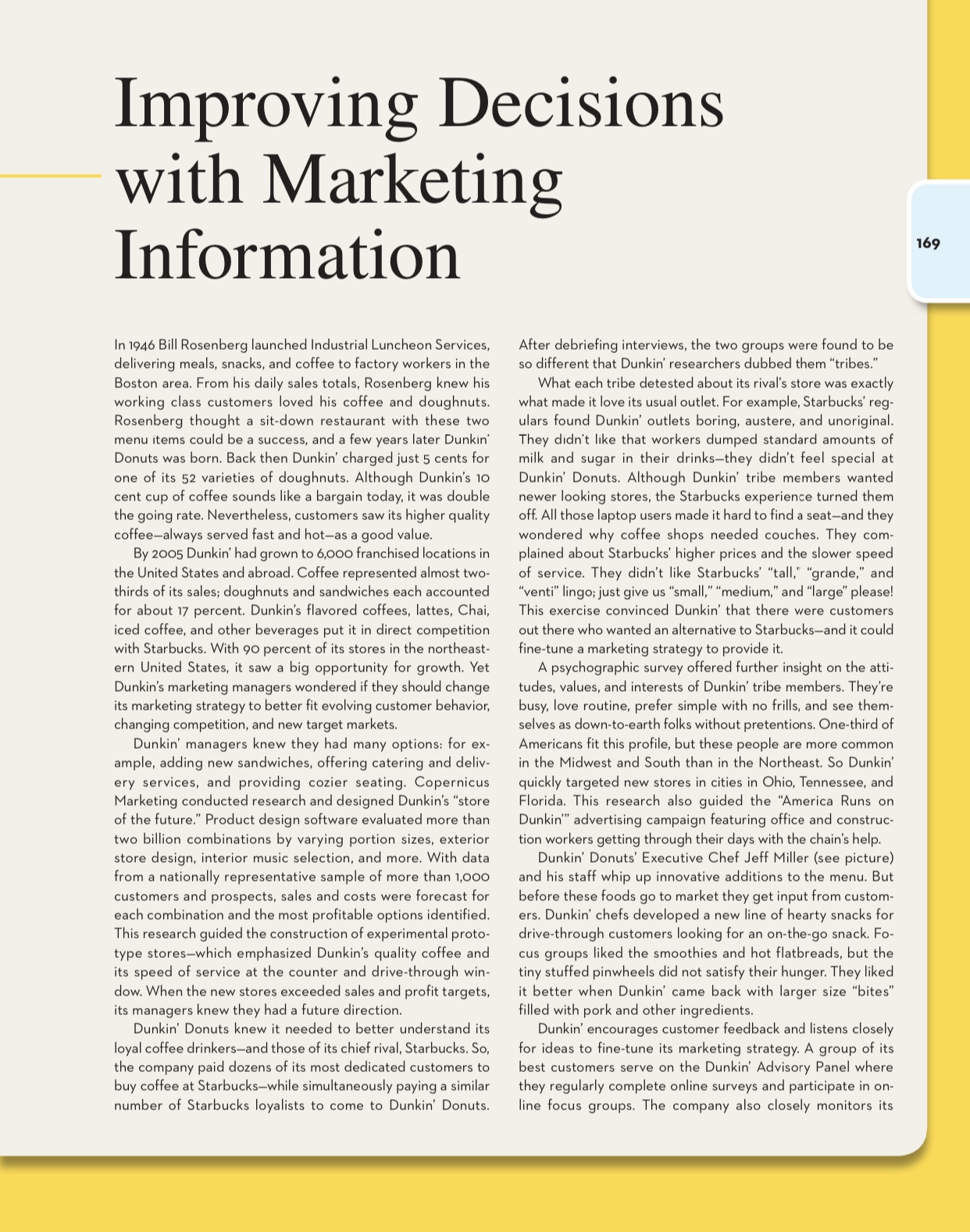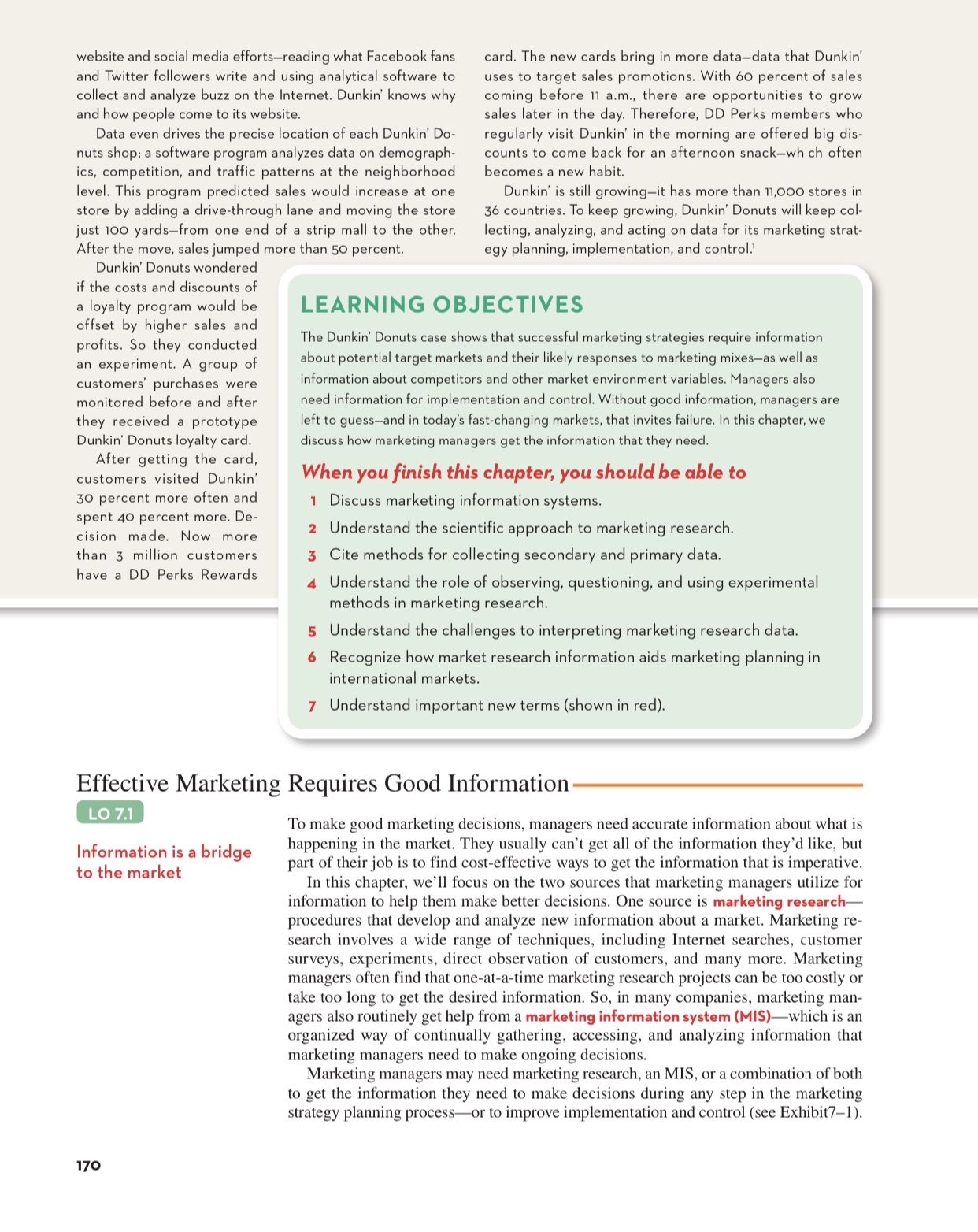1.The Dunkin' Donuts case study (p. 169-170) includes some information on how the company encourages and obtains customer feedback. Please explain how the company is getting customer feedback data to fine-tune its marketing strategy
Improving Decisions with Marketing Information In 1946 Bill Rosenberg launched Industrial Luncheon Services, delivering meals, snacks, and coffee to factory workers in the Boston area. From his daily sales totals. Rosenberg knew his working class customers loved his coffee and doughnuts. Rosenberg thought a sit-down restaurant with these two menu items could be a success. and a few years later Dunkin' Donuts was born. Back then Dunkin' charged just 5 cents for one of its 52 varieties of doughnuts. Although Dunkin's 10 cent cup of coffee sounds like a bargain today. it was double the going rate. Nevertheless. customers saw its higher quality coffeealways served fast and hotas a good value. By 2005 Dunkin' had grown to 6,000 franchised locations in the United States and abroad. Coffee represented almost two- thirds of its sales; doughnuts and sandwiches each accounted for about 17 percent. Dunkin's flavored coffees. lattes. Chai. iced coffee, and other beverages put it in direct competition with Starbucks. With 90 percent of its stores in the northeast- ern United States, it saw a big opportunity for growth. Yet Dunkin's marketing managers wondered if they should change its marketing strategy to better fit evolving customer behavior. changing competition, and new target markets. Dunkin' managers knew they had many options: for ex- ample. adding new sandwiches. offering catering and deliv- ery services. and providing cozier seating. Copernicus Marketing conducted research and designed Dunkin's "store of the future.\" Product design software evaluated more than two billion combinations by varying portion sizes. exterior store design, interior music selection. and more. With data from a nationally representative sample of more than 1,000 customers and prospects. sales and costs were forecast for each combination and the most profitable options identified. This research guided the construction of experimental proto- type storeswhich emphasized Dunkin's quality coffee and its speed of service at the counter and drive-through win- dow. When the new stores exceeded sales and profit targetsI its managers knew they had a future direction. Dunkin' Donuts knew it needed to better understand its loyal coffee drinkersand those of its chief rival. Starbucks. So. the company paid dozens of its most dedicated customers to buy coffee at Starbuckswhile simultaneously paying a similar number of Starbucks loyalists to come to Dunkin' Donuts. After debriefing interviews. the two groups were found to be so different that Dunkin' researchers dubbed them "tribes." What each tribe detested about its rival's store was exactly what made it love its usual outlet. For example. Starbucks' reg- ulars found Dunkin' outlets boring, austere. and unoriginaL They didn't like that workers dumped standard amounts of milk and sugar in their drinksthey didn't feel special at Dunkin' Donuts. Although Dunkin' tribe members wanted newer looking stores. the Starbucks experience turned them off. All those laptop users made it hard to find a seatand they wondered why coffee shops needed couches. They com- plained about Starbucks' higher prices and the slower speed of service. They didn't like Starbucks' "tall,\" \"grande.\" and "venti" lingo; just give us \"small." \"medium." and I'large" please! This exercise convinced Dunkin' that there were customers out there who wanted an alternative to Starbucksand it could fine-tune a marketing strategy to provide it. A psychographic survey offered further insight on the atti- tudes. values. and interests of Dunkin' tribe members. They're busy. love routine. prefer simple with no frills. and see them- selves as down-toearth folks without pretentions. One-third of Americans fit this profile. but these people are more common in the Midwest and South than in the Northeast. 50 Dunkin' quickly targeted new stores in cities in Ohio, Tennessee, and Florida. This research also guided the "America Runs on Dunkin'\" advertising campaign featuring office and construc- tion workers getting through their days with the chain's help. Dunkin' Donuts' Executive Chef Jeff Miller [see picture) and his staff whip up innovative additions to the menu. But before these foods go to market they get input from custom- ers. Dunkin' chefs developed a new line of hearty snacks for drive-through customers looking for an on-the-go snack, Fo- cus groups liked the smoothies and hot flatbreads. but the tiny stuffed pinwheels did not satisfy their hunger. They liked it better when Dunkin' came back with larger size "bites" filled with pork and other ingredients. Dunkin' encourages customer feedback and listens closely for ideas to fine-tune its marketing strategy. A group of its best customers serve on the Dunkin' Advisory Panel where they regularly complete online surveys and participate in on- line focus groups. The company also closely monitors its 169 website and social media effortsreading what Facebook fans and Twitter followers write and using analytical software to collect and analyze buzz on the Internet. Dunkin' knows why and how people come to its website. Data even drives the precise location of each Dunkin' Do- nuts shop: a software program analyzes data on demograph- ics, competition, and traffic patterns at the neighborhood level. This program predicted sales would increase at one store by adding a drive-through lane and moving the store just 100 yardsfrom one end of a strip mall to the other. card. The new cards bring in more datadata that Dunkin' uses to target sales promotions. With 60 percent of sales coming before 11 a.m.. there are opportunities to grow sales later in the day. Therefore, DD Perks members who regularly visit Dunkin' in the morning are offered big dis- counts to come back for an afternoon snackwhich often becomes a new habit. Dunkin' is still growingit has more than 11,000 stores in :56 countries. To keep growing. Dunkin' Donuts will keep col- lecting. analyzing. and acting on data for its marketing strat- After the move, salesjumped more than 50 percent. egy planning. implementation, and control.' Dunkin' Donuts wondered if the costs and discounts of a loyalty program would be offset by higher sales and profits. So they conducted an experiment. A group of LEARNING OBJECTIVES The Dunkin' Donuts case shows that successful marketing strategies require information about potential target markets and their likely responses to marketing mixesas well as customers' purchases were information about competitors and other market environment variables. Managers also monitored before and after they received a prototype Dunkin' Donuts loyalty card. After getting the card. ' ' _ customer. visited Dunkin' When you finish this chapter, you should be able to so percent more often and 1 spent 40 percent more. De- need information for implementation and control. Without good information. managers are left to guessand in today's fast-changing markets, that invites failure. In this cha pter, we discuss how marketing managers get the information that they need. Discuss marketing information systems. . . 2 Understand the scientific approach to marketing research. CISIon made. NOW more than 3 million customers 5 Cite methods for collecting secondary and primary data. 4 have a DD Perks Rewards Understand the role of observing, questioning. and using experimental methods in marketing research. Understand the challenges to interpreting marketing research data. Recognize how market research information aids marketing planning in international markets. 7 Understand important new terms (shown in red). Effective Marketing Requires Good Information Information is a bridge to the market To make good marketing decisions. managers need accurate information about what is happening in the market. They usually can't get all of the information they'd like. but part of their job is to find cost-effective ways to get the information that is imperative. In this chapter. we'll focus on the two sources that marketing managers utilize for information to help them make better decisions. One source is marketing research procedures that develop and analyze new information about a market. Marketing re- search involves a wide range of techniques. including Internet searches. customer surveys. experiments, direct observation of customers. and many more. Marketing managers often find that one-at-a-time marketing research projects can be too costly or take too long to get the desired information. So. in many companies. marketing man agers also routinely get help from a marketing information system (MIS}which is an organized way of continually gathering. accessing. and analyzing information that marketing managers need to make ongoing decisions. Marketing managers may need marketing research, an M18. or a combination of both to get the information they need to make decisions during any step in the marketing strategy planning processor to improve implementation and control (see Exhibit7l ). 170








